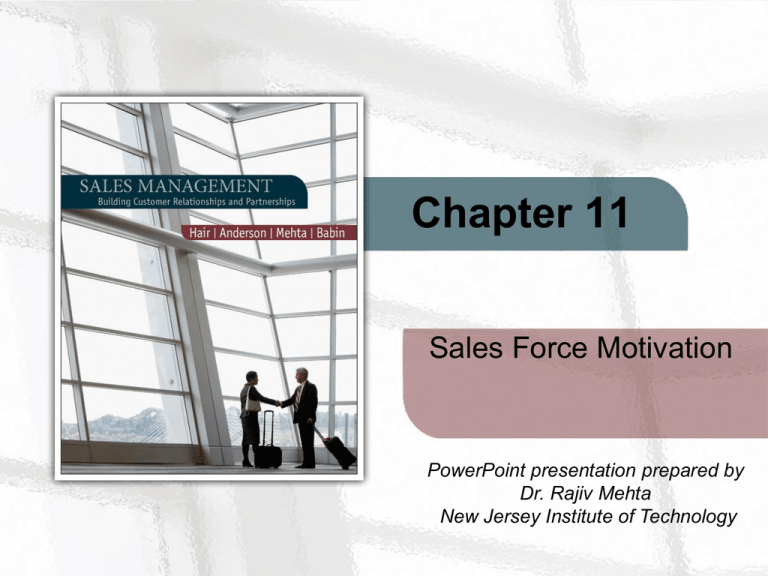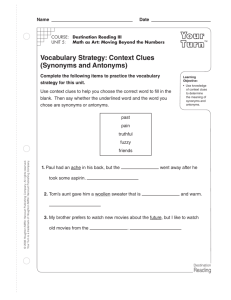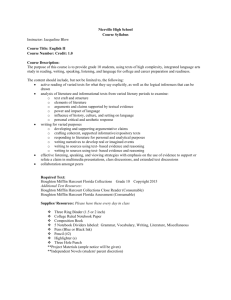
Chapter 11
Sales Force Motivation
PowerPoint presentation prepared by
Dr. Rajiv Mehta
New Jersey Institute of Technology
Chapter Outline
• Foundations of Motivation
• Applying Contemporary Motivation Theories to
Sales Management
• Using Rewards and Incentive Programs for
Sales Force Motivation
• Sales Force Motivation Strategies and Tools
• Additional Perspectives in Twenty-First Century
Sales Force Motivation
Copyright © Houghton Mifflin Harcourt Publishing Company. All rights reserved.
11 | 2
Learning Objectives
After reading this chapter, you should be
able to do the following:
1. Understand the nature of motivation.
2. Apply contemporary theories of motivation to sales
management.
3. Design reward and incentive programs to motivate
salespeople.
4. Develop sales contests and sales meetings to motivate
salespeople.
5. Use organizational commitment, career stage, and
empowerment to motivate a sales force.
Copyright © Houghton Mifflin Harcourt Publishing Company. All rights reserved.
11 | 3
Foundations of Motivation
• Motivation is the set of dynamic
interpersonal processes that
cause the initiation, direction,
intensity, and persistence of
work-related behaviors of
subordinate salespeople toward
the attainment of organizational
goals and objectives.
– Direction means tasks on which
the individual will focus effort.
– Intensity refers to the amount of
physical and mental effort
expended on a given task.
– Persistence refers to the
duration of the effort an
individual will exert.
Copyright © Houghton Mifflin Harcourt Publishing Company. All rights reserved.
Source: Stockybte
11 | 4
Applying Contemporary Motivation Theories
to Twenty-First Century Sales Management
1.
Content
theories
•
•
•
•
Content theories provide
insights into employees’
needs for rewards and
recognition, which can help
sales managers design
compensation plans and
rewards that motivate
salespeople.
hierarchy of needs theory
existence, relatedness,
growth (ERG) theory
needs theory
dual factor theory
Contemporary
motivation
theories
2.
Process
theories
3.
Reinforcement
oriented
theories
also known as organizational
behavior modification theory
Copyright © Houghton Mifflin Harcourt Publishing Company. All rights reserved.
•
•
•
•
Process theories
emphasize the kind of
goals and rewards that
motivate people.
Specifically, they try to
explain the thought
process of employees and
identify actions that fulfill
their needs.
equity theory
expectancy theory
attribution theory
goal-setting theory
11 | 5
Maslow’s Hierarchy of Needs
•
•
•
Maslow’s hierarchy is one of several motivation theories that explain human
behavior.
Humans satisfy lower-level needs before attempting to satisfy the next
higher-level need.
What are Maslow’s five levels of needs?
higher-
level
needs
lowerlevel
needs
Copyright © Houghton Mifflin Harcourt Publishing Company. All rights reserved.
11 | 6
Maslow’s Hierarchy of Needs
Maslow’s
hierarchy is
one of
several
motivation
theories that
explain
human
behavior.
self-actualization
higherlevel
needs
esteem needs
social needs
safety needs
lowerlevel
needs
physiological needs
How can this theory be used in sales management?
Copyright © Houghton Mifflin Harcourt Publishing Company. All rights reserved.
11 | 7
Existence, Relatedness,
Growth (ERG) Theory
1.
Existence
• similar to Maslow’s
physiological and
safety needs
ERG theory
3.
Growth
2.
Relatedness
• similar to Maslow’s
social and esteem
needs
• similar to Maslow’s selfactualization needs
Copyright © Houghton Mifflin Harcourt Publishing Company. All rights reserved.
11 | 8
Needs Theory
1.
Need for
power
• reflects the drive to
dominate, influence,
and have authority
to control others
Needs theory
3.
Need for
affiliation
2.
Need for
achievement
• the strong urge to
master and
accomplish difficult
tasks
• the desire to establish
friendships, to have
close working
relationships with peers
as well as customers,
and to avoid conflict
Copyright © Houghton Mifflin Harcourt Publishing Company. All rights reserved.
11 | 9
Dual Factor Theory
(aka Motivation-Hygiene Theory)
1.
Motivation
factors
•
•
•
Dual factor
theory
Sources of satisfaction are
called motivators because they
are necessary to stimulate
individuals to superior efforts.
They include responsibility,
achievement, recognition, and
opportunities for growth and
advancement.
When present, they motivate
salespeople; if absent, they
demotivate them.
Copyright © Houghton Mifflin Harcourt Publishing Company. All rights reserved.
2.
Hygiene
factors
•
•
Hygiene factors are extrinsic
aspects of the job, such as
company policies, pay level,
fringe benefits, working
conditions, and job security.
When present, hygiene factors do
not actually induce positive
motivation in salespeople; their
absence, however, leads to
salesperson dissatisfaction and
demotivation.
11 | 10
Equity Theory
• Equity theory of motivation
suggests that employees
compare their relative work
contributions and rewards with
those of other individuals in
similar situations.
• Employees experience inequity
when they feel either under- or
over-rewarded for their
contribution relative to that of
others.
–
Those who feel under-rewarded
decrease their work efforts; people
who feel overpaid tend to increase
theirs.
• If salespeople perceive
inequity, remedy the situation.
Copyright © Houghton Mifflin Harcourt Publishing Company. All rights reserved.
Source: Stockbyte
11 | 11
Expectancy Theory
• Expectancy theory of motivation
proposes that individuals contemplate the
consequences of personal actions in
choosing different alternatives to satisfy
their needs.
• Symbolically,
n
Ei I j V jk
•
Motivation =
j 1
– Ei = Expectancy is the salesperson’s
perception that exerting a given level of effort
will lead to higher achievement.
– Ij = Instrumentality is the salesperson’s
estimate of the probability that achieving a
certain level of improved performance will lead
to the attainment of certain rewards.
– jk = Valence is the desirability of a potential
outcome or reward that the salesperson may
receive from improved performance.
Copyright © Houghton Mifflin Harcourt Publishing Company. All rights reserved.
Source: Triangle Images
11 | 12
Attribution Theory
• Attribution theory identifies the reasons for
a given outcome and contends that people
are motivated to know why an event
occurred and why they succeeded or failed
at a certain task.
•
An internal attribution is a reason within the
salesperson that could affect performance
(ability, effort, skill, and experience).
•
An external attribution is an explanation that
lies beyond the salesperson’s realm of
control (luck, territory, or task difficulty).
•
The outcome is that salespeople can
choose either to work harder or to work
Source: Stockbyte
smarter.
Copyright © Houghton Mifflin Harcourt Publishing Company. All rights reserved.
11 | 13
Goal-Setting Theory
•
Goal-setting theory attempts to increase motivation by linking
rewards directly to salespersons’ goals.
•
Sales managers should set these types of goals:
– goals for individual salespeople
– goals that are moderately difficult to achieve
– goals that the salesperson will want to accomplish
•
Successful implementation of goal setting includes the following:
– Involve the salesperson in the goal-setting process to set
realistic goals.
– Meet and reset goals if conditions change.
– Fix goals that can be measured (time or dollar volume).
– Provide positive feedback on how to correct shortfalls.
– Provide timely public recognition for goal achievement.
Copyright © Houghton Mifflin Harcourt Publishing Company. All rights reserved.
Source: Stockbyte
11 | 14
Goal Setting
• To see an excellent video on using goal setting to
motivate the sales force, go to
– http://www.sellingpower.com/video/index.asp?date=2/8/2007
Copyright © Houghton Mifflin Harcourt Publishing Company. All rights reserved.
11 | 15
Reinforcement Theory of Motivation
(aka Organizational Behavior Modification)
• This theory uses principles of learning to
strengthen, maintain, or eliminate
behaviors through rewards or
punishments.
• Here are four approaches:
– Positive reinforcement provides a reward for a
desired behavior (bonus for opening new
accounts).
– Negative reinforcement allows salespeople to
avoid an undesirable outcome.
– Punishment provides sanction when salespeople
display an undesired behavior.
– Extinction provides no positive reinforcement
after an undesirable behavior.
Copyright © Houghton Mifflin Harcourt Publishing Company. All rights reserved.
Source: Stockbyte
11 | 16
To Motivate Salespeople,
Sales Managers Must Recognize
•
•
•
•
•
All salespeople are different.
Motivators change over time.
Once financial security is achieved,
other motivators must be considered.
Praise and recognition are extremely
important motivators for all
salespeople.
For salespeople to do their jobs well,
they need the following:
–
–
–
–
to be told what is expected of them
to be trained to perform properly
to be evaluated fairly and regularly
to be rewarded for performance
Copyright © Houghton Mifflin Harcourt Publishing Company. All rights reserved.
Source: Stockbyte
11 | 17
Articles on Sales Force Motivation
• To read articles on motivating the sales force, go to
– http://www.optimalthinking.com/sales-force-motivation.html
– http://www.inc.com/resources/leadership/articles/20070801/mus
selwhite.html
• Read about sales motivation and the role of leadership
at
– http://ezinearticles.com/?Sales-Motivation-and-the-Role-ofLeadership&id=701426
• Read an excellent article on sales leadership, motivating
your sales team to the next level, at
– http://www.agora-business-center.com/0907b2b.html
Copyright © Houghton Mifflin Harcourt Publishing Company. All rights reserved.
11 | 18
Using Rewards and Incentive Programs
for Sales Force Motivation
salary, stock
options, profit
sharing
recognition,
plaques, rings
cash, travel,
awards
1.
Extrinsic
rewards
5.
Recognition
Reward and
incentive
programs
4.
Intrinsic
rewards
respect, status,
control,
accomplishment
Copyright © Houghton Mifflin Harcourt Publishing Company. All rights reserved.
2.
Sales incentive
programs
3.
Promotion
opportunities
career path with
promotions
11 | 19
Sales Incentives Programs
• To see a video on sales incentives, go to
– http://www.sellingpower.com/video/index.asp?date=1
0/31/2006
Copyright © Houghton Mifflin Harcourt Publishing Company. All rights reserved.
11 | 20
How to Run a Sales
Incentive Program
• To see an excellent video on how to administer
a sales incentive program that motivates the
sales force, visit
– http://www.sellingpower.com/video/index.asp?date=4
/27/2007
Copyright © Houghton Mifflin Harcourt Publishing Company. All rights reserved.
11 | 21
Sales Force Motivation
Strategies and Tools
1.
Sales contests
Motivation
strategies
Copyright © Houghton Mifflin Harcourt Publishing Company. All rights reserved.
2.
Sales meetings
11 | 22
Sales Contests
1. Sales contests: purposes
– increase number of new
customers
– develop sales of a new
product
– counteract sales slumps
due to seasonal variations
2. Contest themes
– summer contest
– holiday contest
3. Contest rules
4. Contest rewards and prizes
Copyright © Houghton Mifflin Harcourt Publishing Company. All rights reserved.
11 | 23
Sales Contests
5. Salesperson participation
6. Contest duration
7. Promoting the contest
8. Assessing contest
Effectiveness
9. Potential pitfalls of contests
Copyright © Houghton Mifflin Harcourt Publishing Company. All rights reserved.
11 | 24
Why Some Sales Contests Are Losers
• overestimating goals
• neglecting to publicize the
contest
• rewarding only the top
salespeople
• leaving spouses at home
• viewing the sales contest as
a panacea
Copyright © Houghton Mifflin Harcourt Publishing Company. All rights reserved.
Source: Stockbyte
11 | 25
Sales Meetings
• National, regional, and local meetings
– National meetings are held once a year.
– Regional meetings are held three to four times a
year.
– Local meetings are regularly held.
• Planning sales meetings
– Establish meeting goals.
– Select a theme on the purpose of the meeting.
– Develop a tentative agenda or program for the
meeting.
– Develop and finalize the program and budget.
– Coordinate closely with all participants.
– Provide handouts.
Copyright © Houghton Mifflin Harcourt Publishing Company. All rights reserved.
Source: Stockbyte
11 | 26
Sales Meetings
• competitive spirit
• specialized training
• change of pace
• video conferences
Copyright © Houghton Mifflin Harcourt Publishing Company. All rights reserved.
11 | 27
Websites for Firms That Help Develop
Sales Force Motivation Programs
• To peruse the websites of various firms that
specialize in developing sales motivation
programs, go to
– http://www.maritzincentives.com/incentives-salesincentives.html
– http://www.hallmarkinsights.com/corp/sales.html
– http://www.sales-train.com
– http://www.incentiveprograms.com/science.asp
Copyright © Houghton Mifflin Harcourt Publishing Company. All rights reserved.
11 | 28
Additional Perspectives in Twenty-First
Century Sales Force Motivation
4.
Salesperson’s
career cycle
3.
Learning versus
performance
orientation
Additional
motivation
perspectives
1.
Organizational and
job commitment
2.
Organizational
climate
Copyright © Houghton Mifflin Harcourt Publishing Company. All rights reserved.
11 | 29
Organizational and Job Commitment
1.
Organizational
commitment
Commitment
• identifying with and
internalizing the
company’s values
and goals and
desiring to stay a
viable member of
the organization
Copyright © Houghton Mifflin Harcourt Publishing Company. All rights reserved.
2.
Job commitment
• the degree of
involvement (high
or low) salespeople
have in their job
11 | 30
Organizational Climate
Organizational climate consists of the perceptions salespeople have
about their work situation and conditions.
formal and informal
relationships among the
salespeople
3.
Organizational
characteristics
company philosophy
about managing
salespeople
4.
Work group
characteristics
Organizational
climate
2.
Leadership
characteristics
Copyright © Houghton Mifflin Harcourt Publishing Company. All rights reserved.
role perceptions,
opportunities, and
problems in the job
1.
Job
characteristics
supervisory styles and
salesperson/sales
manager relationships
11 | 31
Learning Versus
Performance Orientation
1.
Learning
orientation
Learning versus
performance
orientation
• Salespeople
discover new ways
of selling effectively
and try new
approaches, even if
doing so leads to
mistakes; they learn
by not repeating
mistakes.
Copyright © Houghton Mifflin Harcourt Publishing Company. All rights reserved.
2.
Performance
orientation
• Performance
orientation
predisposes
salespeople to work
hard and generate
sales.
11 | 32
Salesperson’s Career Cycle
Salespeople may be preparing
for retirement and may
psychologically withdraw from
the job by making fewer sales
calls per day, may call solely on
existing accounts rather than
on prospects, and may lose
interest in their work.
3.
Maturity or
maintenance
stage
Salespeople hold on to
what has already been
achieved—position, status,
image, and performance
level.
4.
Decline or
disengagement
stage
Career stages
2.
Development or
establishment
stage
Copyright © Houghton Mifflin Harcourt Publishing Company. All rights reserved.
Salespeople's priority is to
build up knowledge and
skills to succeed in their
new job.
1.
Preparation or
exploration stage
Salespeople become
committed to the selling
profession, seek stability in
their professional and
personal lives, and
strongly desire
professional success.
11 | 33
Sales Force Motivation
• See videos on various issues related to sales
force motivation at
– http://www.sellingpower.com/video/?date=2/23/2007
– http://www.sellingpower.com/video/index.asp?date=4
/26/2007
Copyright © Houghton Mifflin Harcourt Publishing Company. All rights reserved.
11 | 34
Sales Force Motivation
• To see videos on how to motivate and reward
top performers, go to
– http://www.sellingpower.com/video/index.asp?date=1
/17/2007
– http://www.jimcathcart.com/videos.aspx
Copyright © Houghton Mifflin Harcourt Publishing Company. All rights reserved.
11 | 35
Ethical Situation: What Would You Do?
Discussion Question
You have been recently appointed regional sales manager for your company. You’re
thrilled with this promotion, especially because you are the youngest regional sales
manager in the company, so it’s obvious that senior management sees you as a real upand-comer and possibly as a replacement for the national sales manager who, at age 64,
is probably thinking about retiring soon. Two of the more senior district sales managers
who report to you are not people you’re comfortable working with. Both have worked at
the company for over twenty years, so they’ve developed strong social networks within
the company. You’re fearful that they may undercut you in some way because they may
be jealous that someone younger was brought in from the outside to be their boss. In
reviewing the performance of their two districts over the past two years, you noted that
they both ranked in the bottom 20%. Perhaps both are in the decline and
disengagement stage of their careers. Thus, you could certainly make the case that their
motivation and careers have plateaued and that they ought to be replaced by new sales
managers in the hard-charging development/establishment stage. Nether district
manager has given you a reason to question their allegiance to you, but you just don’t
like to have such experienced, well-connected subordinates who might be able to go
around you to talk to your bosses. Therefore, you’ve decided to start making a case to
replace these two district managers, and one of the first things you’re going to do is
significantly increase the sales quotas for their districts.
Copyright © Houghton Mifflin Harcourt Publishing Company. All rights reserved.
11 | 36



